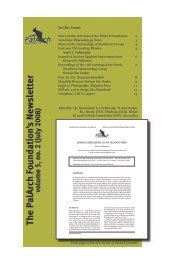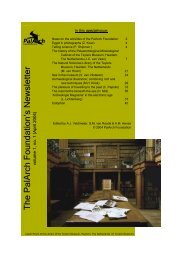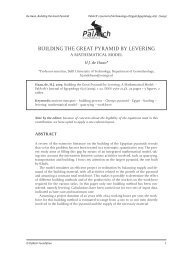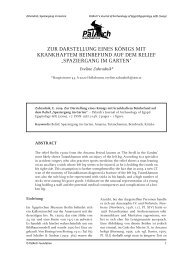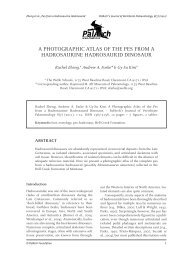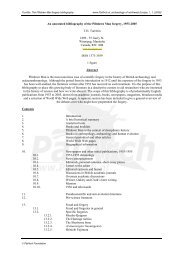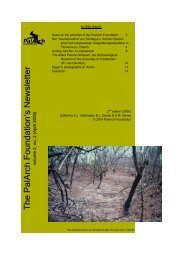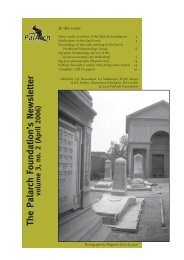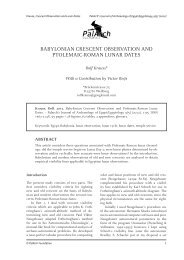neural spine bifurcation in sauropod dinosaurs of the - PalArch
neural spine bifurcation in sauropod dinosaurs of the - PalArch
neural spine bifurcation in sauropod dinosaurs of the - PalArch
Create successful ePaper yourself
Turn your PDF publications into a flip-book with our unique Google optimized e-Paper software.
Wedel & Taylor, Neural Sp<strong>in</strong>e Bifurcation <strong>in</strong> Sauropods <strong>PalArch</strong>’s Journal <strong>of</strong> Vertebrate Palaeontology, 10(1) (2013)<br />
Figure 9. Degree <strong>of</strong> <strong>neural</strong> <strong>sp<strong>in</strong>e</strong> <strong>bifurcation</strong> <strong>of</strong> presacral vertebrae <strong>in</strong> well-preserved Morrison Formation <strong>sauropod</strong> specimens<br />
represent<strong>in</strong>g several taxonomic groups. In all taxa with deep <strong>bifurcation</strong>s, <strong>the</strong>se are concentrated around <strong>the</strong> cervico-dorsal<br />
transition. ‘No data’ markers may mean that <strong>the</strong> vertebrae are not preserved (e.g., posterior dorsals <strong>of</strong> Suuwassea emilieae<br />
ANS 21122), that <strong>the</strong> degree <strong>of</strong> <strong>bifurcation</strong> cannot be assessed (e.g., anterior cervicals <strong>of</strong> Diplodocus carnegii CM 84/94), or<br />
that <strong>the</strong> serial positions <strong>of</strong> <strong>the</strong> vertebrae are uncerta<strong>in</strong> so <strong>the</strong>y contribute no <strong>in</strong>formation on serial changes <strong>in</strong> <strong>bifurcation</strong><br />
(e.g., <strong>the</strong> four cervical vertebrae known for Barosaurus lentus YPM 429). The Camarasaurus specimens are roughly <strong>in</strong><br />
ontogenetic order: C. lentus CM 11338 is a juvenile, C. grandis YPM 1905 and GMNH-PV 101/WPL 1995, and C. supremus<br />
AMNH 5761 are adults, and C. lewisi BYU 9047 is geriatric. See text for sources <strong>of</strong> data.<br />
The presacral vertebral formulae are assumed<br />
to be as follows: 15 cervicals and 10 dorsals<br />
<strong>in</strong> Apatosaurus and Diplodocus, 16 cervicals<br />
and 9 dorsals <strong>in</strong> Barosaurus, and 12 cervicals<br />
and 12 dorsals <strong>in</strong> Camarasaurus. In each group,<br />
only <strong>the</strong> <strong>in</strong>formative specimens are listed; for<br />
example, <strong>the</strong> cervical vertebrae <strong>of</strong> Barosaurus<br />
lentus YPM 429 are <strong>of</strong> uncerta<strong>in</strong> serial position,<br />
so this specimen is not <strong>in</strong>cluded <strong>in</strong> <strong>the</strong> descriptions<br />
<strong>of</strong> cervical vertebrae.<br />
A note on preservation: when material is<br />
broken or <strong>in</strong>complete, it is easier to detect deep<br />
<strong>bifurcation</strong>s than shallow ones. The <strong>neural</strong><br />
<strong>sp<strong>in</strong>e</strong> tips are usually narrow, fragile, and easily<br />
broken or lost. If a vertebra is miss<strong>in</strong>g <strong>the</strong><br />
top half <strong>of</strong> its <strong>sp<strong>in</strong>e</strong> but <strong>the</strong> bottom half is not<br />
split, it is impossible to say whe<strong>the</strong>r <strong>the</strong> com-<br />
plete vertebra was bifid or not. But if <strong>the</strong> <strong>sp<strong>in</strong>e</strong><br />
is deeply bifurcated, even a small piece <strong>of</strong> bone<br />
from <strong>the</strong> base <strong>of</strong> <strong>the</strong> trough or one <strong>of</strong> <strong>the</strong> metapophyses<br />
is enough to confirm that it was bifid.<br />
Cervical Vertebrae<br />
Apatosaurus louisae CM 3018 (Gilmore, 1936:<br />
195 and plate 24) – Impossible to assess <strong>in</strong> C2-<br />
C5, at least shallowly bifid <strong>in</strong> C6, deeply bifid <strong>in</strong><br />
C7-C15. Accord<strong>in</strong>g to Gilmore (1936: 195): “Unfortunately<br />
<strong>the</strong> type <strong>of</strong> A. louisae lacks most <strong>of</strong><br />
<strong>the</strong> <strong>sp<strong>in</strong>e</strong> tops, only those <strong>of</strong> cervicals eight, ten<br />
and twelve be<strong>in</strong>g complete; thus <strong>the</strong> po<strong>in</strong>t <strong>of</strong><br />
change from s<strong>in</strong>gle to bifid <strong>sp<strong>in</strong>e</strong>s cannot be determ<strong>in</strong>ed<br />
<strong>in</strong> this specimen.” However, Gilmore<br />
(1936: plate 24) shows <strong>the</strong> base <strong>of</strong> <strong>the</strong> cleft preserved<br />
<strong>in</strong> C6 and C7, <strong>in</strong>dicat<strong>in</strong>g that those ver-<br />
© <strong>PalArch</strong> Foundation 10



